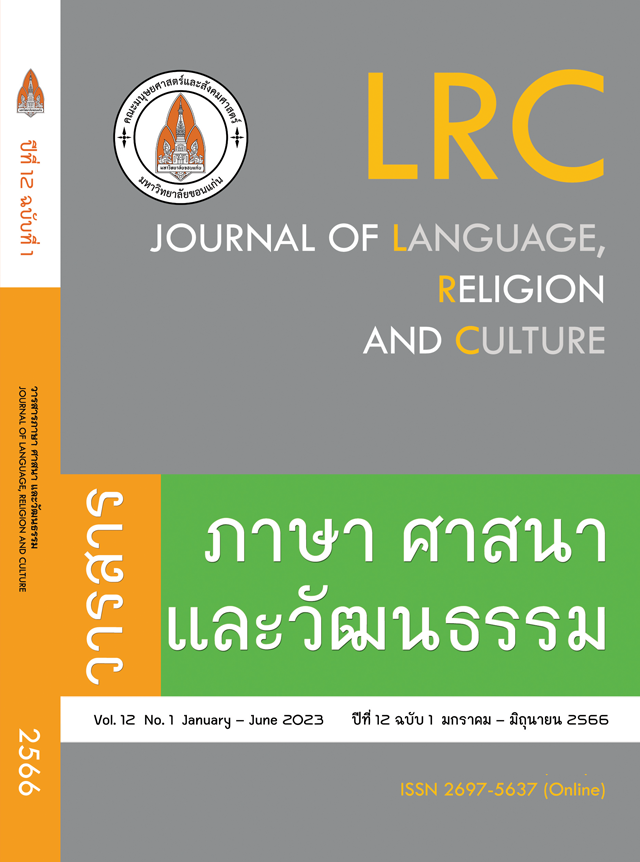คุณลักษณะความเป็นหน่วยสร้างกริยาเรียงของประโยคภาษาไทยที่เป็นคู่เทียบความหมายของ หน่วยสร้างบุพบทวลี 把ในภาษาจีน
คุณลักษณะความเป็นหน่วยสร้างกริยาเรียงของประโยคภาษาไทยที่เป็นคู่เทียบความหมายของ หน่วยสร้างบุพบทวลี 把ในภาษาจีน
คำสำคัญ:
หน่วยสร้างบุพบทวลี把, หน่วยสร้างกริยาเรียงบทคัดย่อ
คำบุพบท把 เป็นคำบุพบทภาษาจีนโดยสมบูรณ์ที่ผ่านกระบวนการกลายเป็นคำไวยากรณ์จากคำกริยา กล่าวคือ ไม่ปรากฏการใช้คำ 把ที่ใช้เป็นกริยาทั่วไปในการสื่อสารภาษาจีนปัจจุบัน เมื่อนำมาเทียบเคียงความหมายกับรูปประโยคภาษาไทยก็มักจะมีการเติมคำกริยาในภาษาไทย เช่น เอา ในตำแหน่งคำบุพบท 把เพื่อให้เกิดการถ่ายทอดโครงสร้างและความหมาย ทั้งนี้ หน่วยสร้างบุพบทวลี 把สามารถถ่ายทอดความหมายได้หลายความหมาย ซึ่งบางความหมายก็ไม่อาจใช้คำ เอา มาเทียบเคียงได้ สำหรับโครงสร้างและความหมายที่สามารถเทียบเคียงโดยใช้คำกริยา เอา ในภาษาไทยอาจนำมาวิเคราะห์ให้เป็นหน่วยสร้างกริยาเรียงได้ แต่ความหมายของหน่วยสร้างบุพบทวลี 把ที่ไม่สามารถวิเคราะห์ให้เป็นหน่วยสร้างกริยาเรียงที่มีคำกริยา เอา เป็นกริยาตำแหน่งที่หนึ่งได้ อาจส่งผลต่อการรับรู้และความเข้าใจความหมายของหน่วยสร้างดังกล่าว งานวิจัยนี้มีวัตถุประสงค์เพื่อศึกษาคุณลักษณะความเป็นหน่วยสร้างกริยาเรียงของประโยคภาษาไทยที่เป็นคู่เทียบความหมายของหน่วยสร้างบุพบทวลี 把ในประเภทความหมายต่าง ๆ ด้วยวิธีการกำหนดลักษณะร่วมและจัดประเภทความหมายของหน่วยสร้างบุพบทวลี 把ที่อ้างอิงจากตำรา 现代汉语八百词 (ภาษาจีนสมัยใหม่ 800 คำ ฉบับปี ค.ศ. 1980) และนำประเภทความหมายของแต่ละกลุ่มมาวิเคราะห์ใหม่ตามคุณสมบัติหน่วยสร้างกริยาเรียงต้นแบบ และเสนอข้อสังเกตที่เป็นประโยชน์ในการสร้างความเข้าใจความหมายของหน่วยสร้างบุพบทวลี 把ในภาษาจีนผ่านแนวคิดเรื่องหน่วยสร้างกริยาเรียงภาษาไทย
ผลการวิจัยพบว่า ความหมายของหน่วยสร้างบุพบทวลี 把ที่สามารถเทียบได้กับหน่วยสร้างกริยาเรียงภาษาไทย คือความหมายสื่อการเคลื่อนย้าย (displacement) และความหมายสื่อเหตุให้เกิด (causative) ความหมายสื่อการเคลื่อนย้ายของหน่วยสร้างบุพบทวลี 把เทียบได้กับหน่วยสร้างกริยาเรียงต้นแบบภาษาไทย และความหมายสื่อเหตุให้เกิดอาจเทียบได้ทั้งกับหน่วยสร้างกริยาเรียงต้นแบบและชายขอบในภาษาไทย แต่ความหมายสื่อการจัดการ (disposal) ของหน่วยสร้างบุพบทวลี 把ไม่สามารถเทียบได้กับหน่วยสร้างกริยาเรียงภาษาไทย เนื่องจากเมื่อเทียบโครงสร้างเป็นภาษาไทยแล้วจะปรากฏคำกริยาเพียงตำแหน่งเดียว ซึ่งไม่ใช่คุณสมบัติพื้นฐานของหน่วยสร้างกริยาเรียง
เอกสารอ้างอิง
กิ่งกาญจน์ เทพกาญจนา. (2553). หน่วยสร้างกริยาเรียงต้นแบบในภาษาไทย. ใน อมรา ประสิทธิ์รัฐสินธุ์ (บรรณาธิการ), หน่วยสร้างที่มีข้อขัดแย้งในไวยากรณ์ไทย (พิมพ์ครั้งที่ 2, น. 66-173). กรุงเทพฯ: โรงพิมพ์ แห่งจุฬาลงกรณ์มหาวิทยาลัย.
ราชบัณฑิตยสถาน. (2556). พจนานุกรมฉบับราชบัณฑิตยสถาน พ.ศ.2554. กรุงเทพฯ: ศิริวัฒนาอินเตอร์พริ้นท์.
ศันสนีย์ เอกอัจฉริยา. (2558). การรับโครงสร้าง “ba” ของผู้เรียนภาษาจีนชาวไทย [วิทยานิพนธ์ปริญญาดุษฎี บัณฑิต]. สาขาวิชาภาษาจีน คณะอักษรศาสตร์ จุฬาลงกรณ์มหาวิทยาลัย.
สุษดี มณีกาญจนสิงห์. (2543). ข้อผิดพลาดในการใช้ภาษาจีนของนิสิตอักษรศาสตร์ จุฬาลงกรณ์มหาวิทยาลัย ชั้น ปีที่ 3 และ 4 [วิทยานิพนธ์ปริญญามหาบัณฑิต]. สาขาวิชาภาษาจีน คณะอักษรศาสตร์ จุฬาลงกรณ์ มหาวิทยาลัย.
Aikhenvald, A. Y., & Dixon, R. M. (2006). Serial Verb Constructions A Cross-Linguistic Typology. Oxford: Oxford University Press.
Beijing Daxue Zhongwen Xi Xiandai Hanyu Jiaoyanshi. (1993). Xiandai Hanyu [Modern Chinese]. Beijing: Shangwu Yinshuguan.
Cholthicha Sudmuk. (2005). The Syntax and Semantics of Serial verb Constructions in Thai [doctoral dissertation]. University of Texas.
Ding, S. (1961). Xiandai Hanyu yufa jianghua [Modern Chinese Grammar the speech]. Beijing: Shangwu Yinshuguan.
Dong, C., & Fan, H. (2006). HSK Yufadian Suji Sulian [Brushing Up Your Grammar for HSK (Elementary & Intermediate)]. Beijing: Beijing Language and Culture University Press.
Huang, B, & Liao, X. (1991). Xiandai Hanyu [Modern Chinese]. Beijing: Higher Education Press.
Kingkarn Thepkanjana. (1986). Serial Verb Constructions in Thai [Doctoral dissertation]. University of Michigan.
Liu, Y., Pan, W., & Gu, W. (2001). Shiyong Xiandai Hanyu Yufa [Practical Grammar of Modern Chinese]. Beijing: Shangwu Yinshuguan.
Lü, S. (1980). Xiandai Hanyu ba bai ci [Modern Chinese 800 Words]. Beijing: Shangwu Yinshuguan.
Ma, Z. (2004). Xiandai Hanyu Xuci Yanjiu Fangfalun [A Research Methodology of Function Words in Modern Chinese]. Beijing: Shangwu Yinshuguan.
Paul R. Kroeger. (2004). Analyzing Syntax A Lexical-Functional Approach. Cambridge: Cambridge University Press.
William J. Frawley. (2003). International Encyclopedia of Linguistics. Oxford: Oxford University Press.
Zhu, D. (1982). Yufa Jiangyi [Grammar Handout]. Beijing: Shangwu Yinshuguan.
ดาวน์โหลด
เผยแพร่แล้ว
รูปแบบการอ้างอิง
ฉบับ
ประเภทบทความ
สัญญาอนุญาต
ลิขสิทธิ์ (c) 2023 วารสารภาษา ศาสนา และวัฒนธรรม

อนุญาตภายใต้เงื่อนไข Creative Commons Attribution-NonCommercial-NoDerivatives 4.0 International License.







